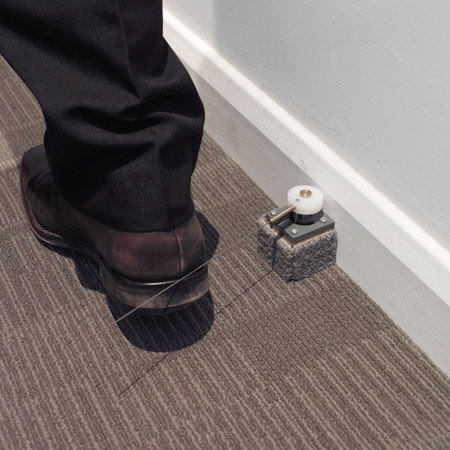Nuisance Machines by British design student Andrew Friend are devices that provoke a reaction from users by dripping dye on their clothes (below), interrupting their conversations or slapping them on their heels as they walk along a corridor (above).
The machines are all designed to be installed in the workplace, where they react to business data. Friend, who is a Design Interactions student at the Royal College of Art in London, hope the machines will trigger new social networks between people affected by them.
Photos are by Hitomi Kai Yoda. Here's some info from Friend:
--
Nuisance Machines
The nuisance machines are a series of speculative devices, aimed at forming interaction through the creation of surreptitious social networks. The machines do not comply with traditional parameters of product design in so much as they are not intended to provide a solution to any specific problems, rather they propose questions and promote awareness regarding our physical surroundings, the integration of technology in this environment, and the position of the ‘designer’ in the formatting of experience.
The nuisance machines aim to trigger the formation of the incidental group, groups formed through the action or reaction of people to an unexpected instance or experience, characterized by the fact that its members may not have originally set out to become a part of the group, rather that they ‘fell’ into it, seemingly through proximity or chance.
The nuisance machines operate as speculative agents, triggering this incidence, scripting ‘coincidence’ (in the psyche of the protagonist), and ultimately formatting new, unintended social networks or groups. The machines explore three methods of group formation; the speculative, through the use of the Stainer, the physical; through the Staller, and non-physical; through the Whisperer.
The Stainer
The Stainer operates as a surreptitious marking tool. The machine is camouflaged so as not to draw unnecessary attention to itself, the Stainer disguised as a light fitting, integrated into the ceilings of its surrounds. The device is networked, releasing dye onto unsuspecting ‘victims’ below. This marking may initially go unnoticed, though upon realization people who have been marked may be grouped by a shared speculation, or confusion as to what is going on around them, and why they may have been ‘chosen’ or picked out. In the office context the machine is placed in the ceilings, here in the transitory spaces between workstations; perhaps placed here by anxious managers, eager to reinforce the corporate structure, or conversely, those attempting to subvert or undermine this order.
Here the Stainer is fed data regarding company profits. Every time that a significant amount of money is lost the machine becomes active. The Stainer then waits… Tripped by a motion sensor in the ceiling fitting the Stainer will release dye onto the next person to pass by. Initially the passers by are grouped thorough a shared speculation, however as people’s awareness of the machine increases the Stainer may become more of a disruptive communication element, in this context marking poor performance, perhaps creating a scapegoat or indicator within the office.
The Whisperer
The Whisperer inhabits the space below tables, disguised as an auxiliary table leg. During periods of silence in its surroundings the machine will quietly start to stream data, in this instance from informal online message boards such a Twitter feeds or Facebook profile updates of the surrounding employees, into it’s environment aurally. The machine juxtaposes spacialities, blending the very formal physical space with much more informal, fluid online spaces, in doing so exploring the boundary between physical and digital domains.
When first encountered the Whisperer may become a source of shared confusion, or even operate sub-consciously as a generator of gossip as personal data is unknowingly shared. Over time the relationship with the machine may develop , and as people start to realize it’s presence their attitudes towards the machines may in turn shift, is the machine treated as an irritation?, or perhaps revered as a link comforting link to the world outside of it’s situation.
The Staller
The Staller operates at a physical level, acting as both aggressor and facilitator the machine physically engages with passers by, leading to potential interaction through simple simultaneous shared experience. The Staller operates at floor level, integrated into the carpets of its situation. The machine occupies narrow transitory spaces such as corridors, doorways or stairs. The machine functions in two parts, in the given context one side is monitoring the market value of the host company, whilst the other, that of rival companies. When the sides are negatively imbalance the machine is activated. The Staller is triggered when two people pass by either side concurrently, causing the staller to snap out and clap the protagonist around the heels. By physically engaging with multiple people the machine leads to unexpected encounters as protagonists are unwittingly pushed toward, and perhaps into one another.
The three machines are all functioning at a discursive level, not aiming to answer, but rather to stimulate debate discussion, and thought, proposing questions. Using a design language and methodology allows people to engage with and imagine the idea. The machines collectively begin to question the integration of technology into our surroundings and the potential for the surreptitious formation of new un-intentional social networks, bringing to the fore questions concerning who may be controlling these networks, is it the anxious manager, the individual, corporation, government, or even totalitarian ‘designer’? To what ends are these groups operating, and how much of the landscape we are operating within is already surreptiously mediated for us?

